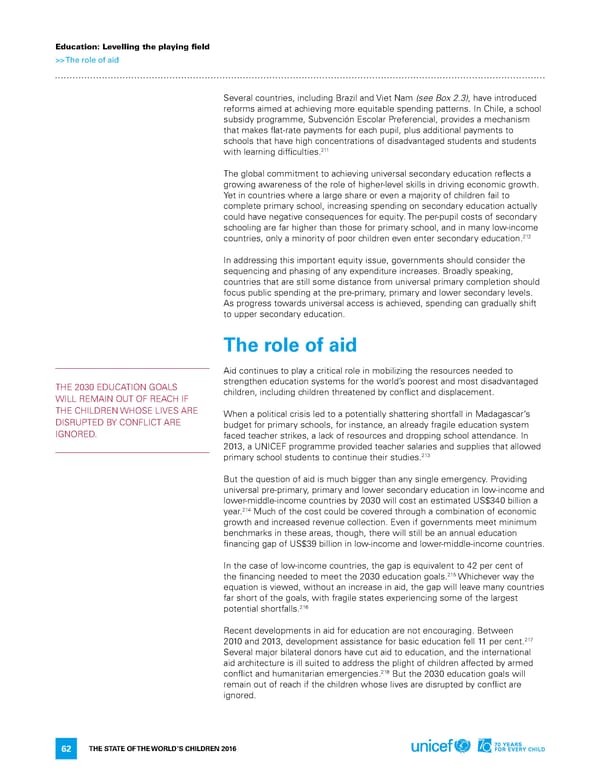Education: Levelling the playing field >> The role of aid Several countries, including Brazil and Viet nam (see Box 2.3), have introduced reforms aimed at achieving more equitable spending patterns. in Chile, a school subsidy programme, Subvención escolar Preferencial, provides a mechanism that makes flat-rate payments for each pupil, plus additional payments to schools that have high concentrations of disadvantaged students and students 211 with learning difficulties. The global commitment to achieving universal secondary education reflects a growing awareness of the role of higher-level skills in driving economic growth. Yet in countries where a large share or even a majority of children fail to complete primary school, increasing spending on secondary education actually could have negative consequences for equity. The per-pupil costs of secondary schooling are far higher than those for primary school, and in many low-income 212 countries, only a minority of poor children even enter secondary education. in addressing this important equity issue, governments should consider the sequencing and phasing of any expenditure increases. Broadly speaking, countries that are still some distance from universal primary completion should focus public spending at the pre-primary, primary and lower secondary levels. as progress towards universal access is achieved, spending can gradually shift to upper secondary education. The role of aid aid continues to play a critical role in mobilizing the resources needed to The 2030 edUCaTion GoalS strengthen education systems for the world’s poorest and most disadvantaged Will reMain oUT of reaCh if children, including children threatened by conflict and displacement. The Children WhoSe liVeS are When a political crisis led to a potentially shattering shortfall in Madagascar’s diSrUPTed BY ConfliCT are budget for primary schools, for instance, an already fragile education system iGnored. faced teacher strikes, a lack of resources and dropping school attendance. in 2013, a UniCef programme provided teacher salaries and supplies that allowed 213 primary school students to continue their studies. But the question of aid is much bigger than any single emergency. Providing universal pre-primary, primary and lower secondary education in low-income and lower-middle-income countries by 2030 will cost an estimated US$340 billion a 214 year. Much of the cost could be covered through a combination of economic growth and increased revenue collection. even if governments meet minimum benchmarks in these areas, though, there will still be an annual education financing gap of US$39 billion in low-income and lower-middle-income countries. in the case of low-income countries, the gap is equivalent to 42 per cent of the financing needed to meet the 2030 education goals.215 Whichever way the equation is viewed, without an increase in aid, the gap will leave many countries far short of the goals, with fragile states experiencing some of the largest potential shortfalls.216 recent developments in aid for education are not encouraging. Between 217 2010 and 2013, development assistance for basic education fell 11 per cent. Several major bilateral donors have cut aid to education, and the international aid architecture is ill suited to address the plight of children affected by armed 218 conflict and humanitarian emergencies. But the 2030 education goals will remain out of reach if the children whose lives are disrupted by conflict are ignored. The STaTe of The World’S Children 2016 62
 70 Years for Every Child Page 77 Page 79
70 Years for Every Child Page 77 Page 79